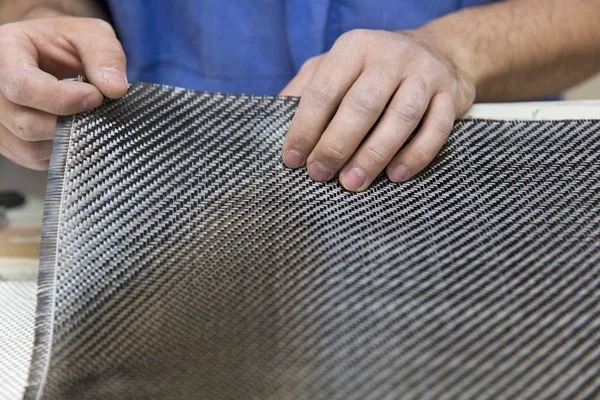- Boat Construction
- Shop Talk
- Composite Fabrication
- Fiberglassing
- Fiberglass Boat Repair
- Techniques & Tips


By Rachael Geerts – GBI Composite Materials Engineer
Have you ever wondered how laminate thickness can be determined without breaking out the epoxy and reinforcement fabric? The answer is simple—use math. While some of you may have just lost interest because you think math is too difficult, I can assure you that this math requires nothing more than some basic multiplication, addition, and division. Let’s get to it.
Here is the equation we’ll use to calculate the average thickness for a single layer of laminate:
In this equation:
tL represents the total composite laminate thickness.
WF represents the aerial weight of the woven or knit reinforcement fabric you are using in your composite laminate.
ρF represents the density of the reinforcement fibers.
ρR represents the density of the resin system you are using. In this instance, the resin system is West System Epoxy.
XF represents the fiber weight fraction, which is determined by the process you are using to create your laminate.
XR represents the resin weight fraction. Like the fiber weight fraction, this will be determined by your processing technique and can be calculated as XR = 1 – XF .
Now that we know what our variables represent, we need to determine their value.
Reinforcement Aerial Weight (WF)
The aerial weight is given by the fabric supplier, but it’s also what you typically call the woven fabric you buy. Ever wonder why fiberglass was called 10 oz. or 17 oz. or maybe why carbon might be called 200 gsm? These are the aerial weights of the fabrics (exact aerial weight is typically given on the spec sheet). 10 oz. is referring to 10 oz./yd2. The same is true for 17 oz. Now, weights like 200 gsm carbon may confuse those of us in the US a little, but gsm stands for grams per square meter. This is a common unit of measure for carbon fiber.
This brings up a good point—check your units! For these equations to work properly you need to make sure you are using the same units—inches to inches or mm to mm, etc. I could go into great detail here about how to convert between different units, but with all the resources available today, you hardly need to do the conversions by hand (although you can if you like math that much!) There are plenty of apps or websites that will do these conversions for you in a matter of seconds, so I would recommend using one of them (or checking your work with one of them).
Fabric and Epoxy Density (ρF and ρR)
While you can find the densities of different fiber reinforcement types in various reference materials, we typically use the values given in this table.
The average density of the West System® 105/20x is about 0.68 oz/in3 or 1.18 g/cm3. Specific densities can be found on our technical datasheets on our website.
Weight Fraction (XF and XR)
Through much research and experience, the composites industry has agreed that the processing technique you use impacts the weight ratio of each component. This means that, if you hand lay up your laminate, the weight fraction (X) values will be different than if you vacuum bag your laminate. This second table contains the X value ranges that are typically accepted in the composites industry. Since the only components of your reinforced laminate are the fibers and the epoxy, XF + XR should always equal one.
The hand lamination technique is suitable for a wide range of applications, however there may be certain times where you need to optimize your laminate for higher performance. Since the laminate fibers carry the majority of the load, it is often best to increase XF and decrease XR to maximize the composite’s strength.
The most common way to increase XF when using epoxy is to vacuum bag your laminate. This means that, after you have thoroughly wet out your reinforcement fabric, you would follow the directions outlined in our Vacuum Bagging Techniques manual. For a flat laminate, you would want to apply a vacuum pressure of 5-12″ of Hg (inches of mercury). For a more complex shape, you would want to apply 12-25″ of Hg to get an even vacuum pressure across the entire laminate. This vacuum pressure helps remove entrapped air and excess epoxy, consolidating the laminate. Again, this is a great way to optimize your laminate, however, it may not be practical or needed for every project. Make sure to consider the full scope of the project before determining which processing method you are going to use.
The Formula in Action
Let’s put our new knowledge to the test. We will calculate the thickness for a fiberglass, hand layup panel made with one layer of 10 oz. fabric and 105 Epoxy Resin® with 205 Fast Hardener®.
Wf – If we use one square yard of 10 oz./yd2 fiberglass then = 10 oz./yd2. We’ll convert this to 0.0077 oz/in2 which will help with units later.
and – We can use 0.5 for our and (right in the middle of the ranges) since our panel will be made via hand lamination. Note: This amount of epoxy will allow you to thoroughly wet out the fiberglass by hand.
ρF – From the density table, we know the average density of fiberglass is 1.47 oz./in3.
ρR – We also know that the density of 105/205 is 0.68 oz./in3.
If we start putting all of the known values into the equation, we get:
A Few Last Thoughts
While the laminate thickness equation may look a little intimidating at first, you now know exactly how to fill it in and solve it. This is a great tool to help you in calculating your laminate thickness, but keep in mind that this equation only gives you an average single-layer thickness. The average takes into account the high spots and low spots in the fabric from the weave. If you were to take some calipers and measure the thickness of a panel made with a single layer of fiberglass, you would likely get a slightly higher number than the calculated thickness because the calipers would rest on the high spots of the fabric.
Remember to double-check your units! They are slippery little fellas and can sometimes get away from you. Make sure to always keep them in check (you should never end up with a single-layer thickness even close to an inch or more with a standard woven or knit reinforcement fabric).
Extract from the WEST SYSTEM User Manual & Product Guide, Reinforcing Materials.
Disclaimers
We do not engineer laminates and therefore cannot recommend a final laminate thickness for builds or repairs. During repairs, we generally recommend replacing the original laminate thickness to maintain or exceed the strength of the original laminate that was designed.
While this equation is accurate, it is still based on some average and nominal values. We do not guarantee that your laminate will be the exact thickness as calculated using this equation.
I hope this makes you feel a little more confident heading into your next composite application. If you have any additional questions feel free to contact our technical staff online or over
the phone at 1-866-937-8797.